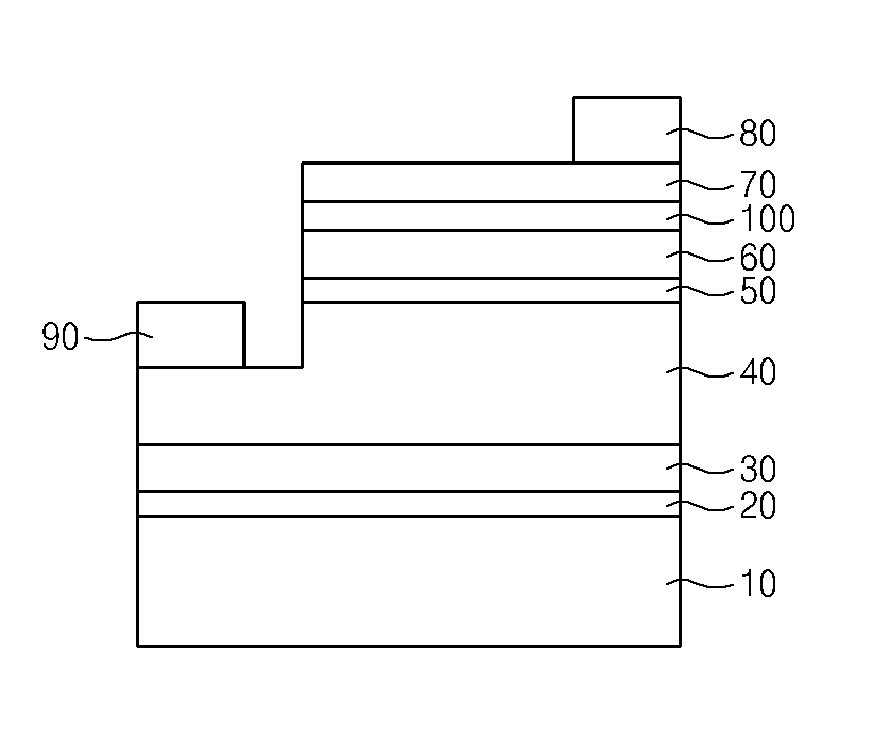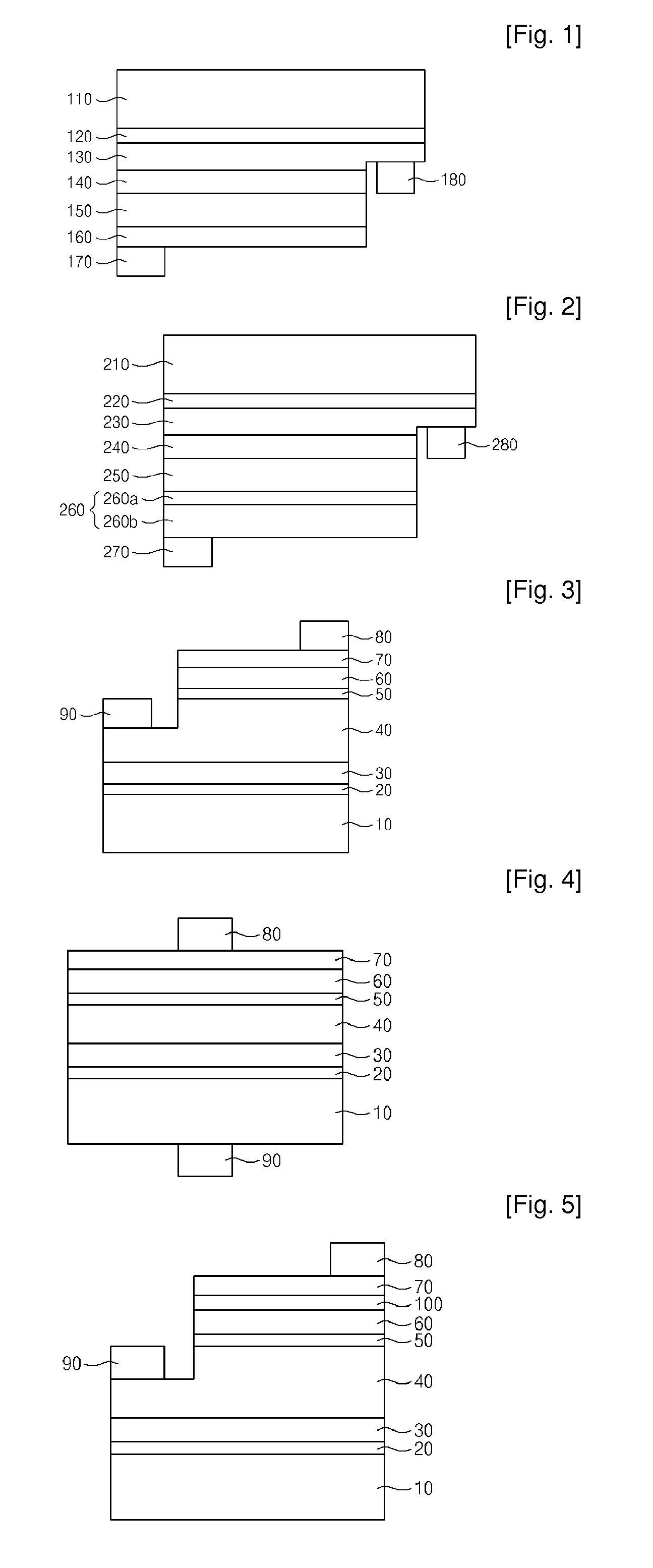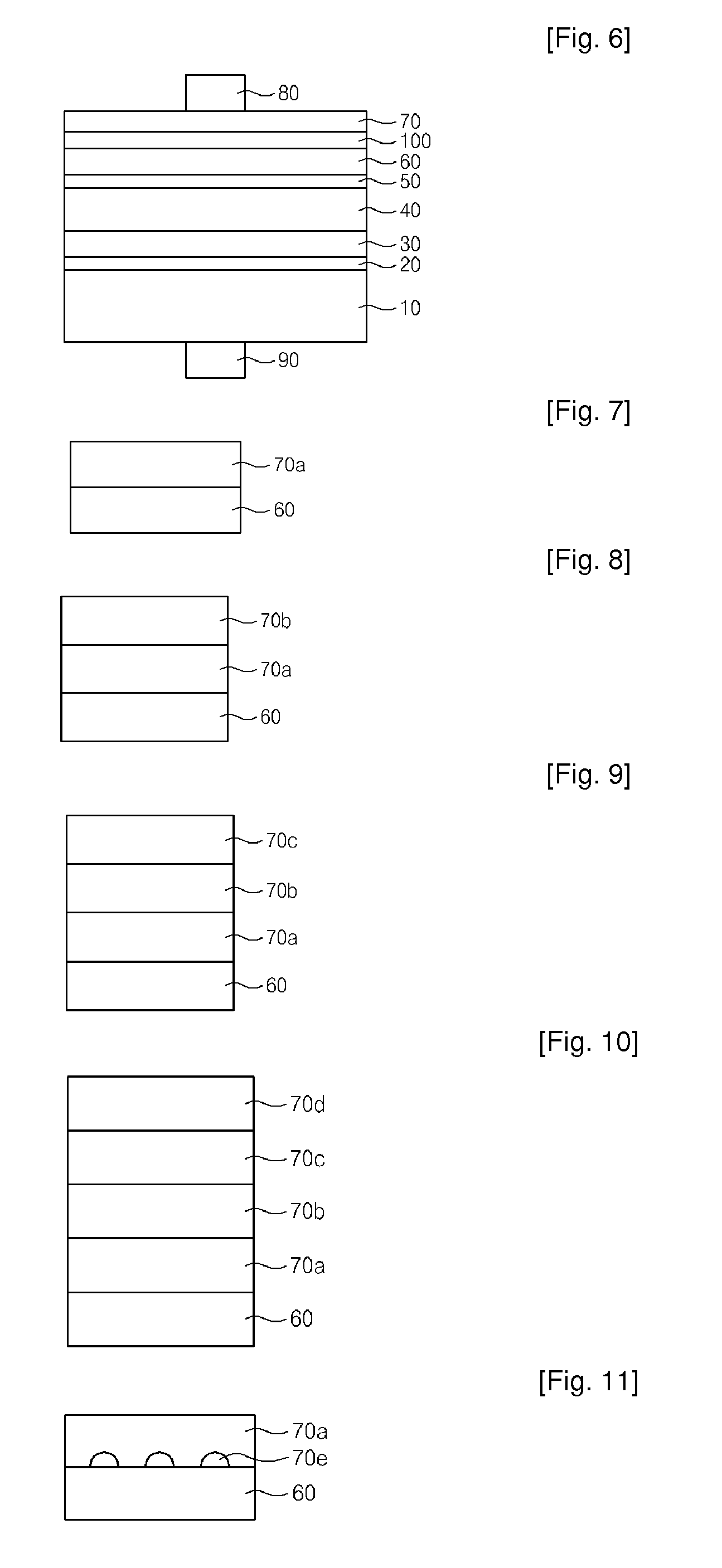Group-III Nitride-Based Light Emitting Device
a light-emitting device and nitride-based technology, which is applied in semiconductor devices, semiconductor device details, electrical apparatus, etc., can solve the problems of poor electric characteristics of top-emission-type light-emitting diodes, poor current injection and current spreading, and poor nitride-based compatibility of spreading layers, etc., to improve the light transmittance of transparent electrodes, improve the ohmic contact characteristics, and improve the current-voltage characteristics
- Summary
- Abstract
- Description
- Claims
- Application Information
AI Technical Summary
Benefits of technology
Problems solved by technology
Method used
Image
Examples
first embodiment
[0052]FIGS. 3 and 4 are sectional views showing a light emitting device employing a p-type multi-layered ohmic contact electrode structure according to the present invention.
[0053]In detail, FIG. 3 shows a group-III nitride-based top-emission type light emitting diode (TELED) employing an insulating growth substrate 10 including sapphire (Al2O3), and FIG. 4 shows a group-III nitride-based top-emission type light emitting diode (TELED) employing a conductive substrate 10 having a conductive material layer including silicon carbide (SiC), zinc oxide (ZnO), silicon (Si), gallium arsenic (GaAs), a metal, such as copper (Cu), nickel (Ni) or aluminum (Al), or an alloy formed through electroplating or a bonding transfer scheme disclosed in various documents.
[0054]Referring to FIG. 3, the group-III nitride-based TELED includes a substrate 10 on which a low-temperature nucleation layer 20, a nitride-based buffer layer 30, an n-type nitride-based cladding layer 40, a nitride-based active laye...
second embodiment
[0077]FIGS. 5 and 6 are sectional views showing a light emitting device employing a p-type multi-layered ohmic contact electrode structure according to the present invention. In FIGS. 5 and 6, the same reference numerals will be assigned to the elements having the same functions and structures as those shown in FIGS. 3 and 4 and detailed description thereof will be omitted in order to avoid redundancy.
[0078]In detail, FIG. 5 shows a group-III nitride-based top-emission type light emitting diode (TELED) employing an insulating growth substrate 10 including sapphire (Al2O3), and FIG. 6 shows a group-III nitride-based top-emission type light emitting diode (TELED) employing a conductive substrate 10 having a conductive material layer including silicon carbide (SiC), zinc oxide (ZnO), silicon (Si), gallium arsenic (GaAs), a metal, such as copper (Cu), nickel (Ni) or aluminum (Al), or an alloy formed through electroplating or a bonding transfer scheme disclosed in various documents.
[0079...
third embodiment
[0105]FIG. 15 is a sectional view showing a flip-chip type nitride-based light emitting device employing an ohmic modification layer according to the present invention.
[0106]Referring to FIG. 15, the p-type multi-layered reflective ohmic contact layer 360 includes an ohmic modification layer 360a and a reflective metal layer 360b which are sequentially stacked. The ohmic modification layer 360a includes the TCON.
[0107]The TCON used for the ohmic modification layer 360a basically includes at least one of indium (In), tin (Sn), zinc (Zn), cadmium (Cd), gallium (Ga), aluminum (Al), magnesium (Mg), titanium (Ti), molybdenum (Mo), nickel (Ni), copper (Cu), silver (Ag), gold (Au), platinum (Pt), rhodium (Rh), iridium (Ir), ruthenium (Ru), and palladium (Pd), combined with both oxygen (O) and nitrogen (N).
[0108]The reflective metal layer 360b includes at least one of aluminum (Al), silver (Ag), rhodium (Rh), palladium (Pd), nickel (Ni), gold (Au), and platinum (Pd). According to the presen...
PUM
 Login to View More
Login to View More Abstract
Description
Claims
Application Information
 Login to View More
Login to View More - R&D
- Intellectual Property
- Life Sciences
- Materials
- Tech Scout
- Unparalleled Data Quality
- Higher Quality Content
- 60% Fewer Hallucinations
Browse by: Latest US Patents, China's latest patents, Technical Efficacy Thesaurus, Application Domain, Technology Topic, Popular Technical Reports.
© 2025 PatSnap. All rights reserved.Legal|Privacy policy|Modern Slavery Act Transparency Statement|Sitemap|About US| Contact US: help@patsnap.com



